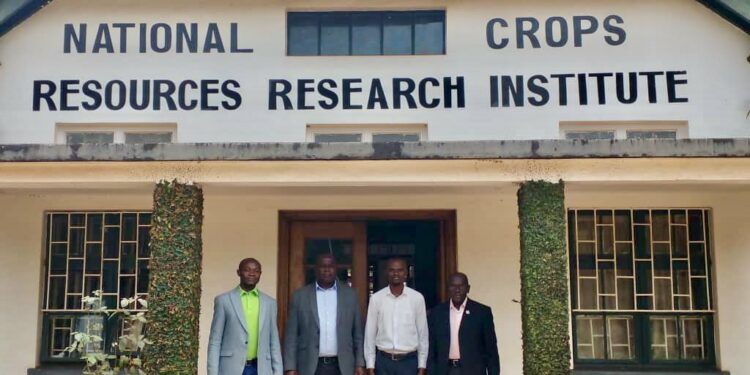By Desire Amanya and Male Solomon Grace
The National Crops Resources Research Institute (NaCRRI) has embarked on availing farmers with improved crop varieties. These research-driven resilient crop varieties and the high-yield varieties are to improve the livelihoods of Ugandans.
NaCRRI has developed, released, and registered 90 crop varieties like maize, beans, rice, cassava, sweet potatoes, mangoes and citruses currently commercially produced in the country.
Maize is one of the staple foods in Uganda, providing over 40% of the citizens’ daily calorie consumption. To meet the country’s maize demand, over two million Ugandans grow maize and consider it a source of income.
One of the reasons Uganda’s maize has failed to reach the international market is the poor post-harvest handling and the presence of aflatoxins which has caused a problem of poor maize quality placing populations at a high health risk.
NaCRRI is on a journey to improve maize standards. Maize is an export commodity for Uganda and the number 5 top commodity after gold, fish, and coffee. Maize brings significant money to the country’s economy every year.
In 2018 and 2021, the media reported Kenyan Authorities blocked 250,000 metric tonnes of maize produce from Uganda for export due to the poor quality and contamination with aflatoxins. NaCRRI is currently running several aflatoxin controls through conventional natural means and a biocontrol process called aflasave.
Maize aside, NaCRRI has also introduced other varieties of sweet potatoes. Sweet potato is another key crop that the institution is doing studies on to improve production and nutrition among the nationals.
A 2017 report from the Uganda National Bureau of Statistics indicates that about 30% of children and 50% of women in Uganda suffer from Vitamin A deficiency, especially in districts of Kamuli, Wakiso, and Mukono.
To avert the situation, the National Crops Resources Research Institute (NaCRRI) provides farmers with improved varieties of orange and purple flesh sweet potatoes rich in vitamin A and carbohydrates.
As you know, wheat has become a challenge nowadays due to the war between Ukraine and Russia. NaCRRI / NARO is working on a sweet-potato curry to substitute wheat for baking bread since the demand for wheat inputs is high and imports have reduced.
According to Dr EPHRAIM Nuwamanya, a Senior Research Scientist with NARO, sweet potato and cassava starch can be great substitutes for wheat.
The researchers are doing studies to improve the production of sweet potatoes, for example, making the shapes uniform for use in industries for chips like KFC, SUMZ snacks e.t.c.
Introduced by Kabaka Muteesa in Uganda! the cassava crop later spread all over the country. NaCRRI is conducting Cassava research to use the crop for food and feed brewing industries for beer like Engule produced by the Buganda Kingdom.
Note that Millions of Africans consume the cassava root tuber as a staple food. However, diseases like the cassava wilt and cassava mosaic disease in the Kafu area for long threatened farmers grow the crop. NaCRRI / NARO has done several studies to control disease epidemics in this crop.
The famous Bukalasa Cassava variety has disappeared because of disease. The new cassava varieties are resistant and can now account for most of these diseases. NaCRRI has done this for all other crops like maize, beans, rice, etc. The new cassava varieties include NAROCASS3, NAROCASS5, and NAROCASS4.
Currently, almost all households in Uganda consume rice daily. Its production has recently increased at an average annual rate of 7.33%. The scientists attribute the growth to promoting and adopting improved rice varieties and a favourable policy environment.
In the last decade, cultivation of the nine (9) superior varieties has boosted rice productivity from the previous national average yield of 1 tonne/acre to 3-4 tons/acre, resulting in increased rice production from 110,000 metric tonnes of milled rice in 2008 to 390,000 metric tons per annum in 2020.
Subsequently, rice importation has reduced from 90,000 metric tonnes to less than 50,000 metric tonnes saving the country over UGX 100 billion.
The price of cooking oil today has doubled. NaCRRI/ NARO is working on increasing the growing oil pam and addressing fusarium disease to produce cooking oil from oil palm.
The institution is doing several multi-location adaptive trials in different ecologies in Uganda to see oil palm grow in other areas outside Kalangala. NaCRRI / NARO has revealed the promise of oil palm to grow in places like Northern Uganda, Eastern Uganda et al.
NaCRRI / NARO has generously promoted the uptake of commodities like finger millet, sorghum, beans, indigenous vegetable oranges, sweet potatoes etc. Indeed the areas where the consumption of these foods is good, incidences of malnutrition are lower. Where it is still prevalent, it’s an issue of awareness and shortages in increasing cultivation of such commodities.
The aim is to get a rich menu of food crops to produce more food and address the issue of malnutrition in areas like Karamoja but also bring in income for the farmer’s household and the revenue for the country.
A lot is in the offing to develop crop varieties and ensure adaptation to the local ecology.
By Desire Amanya and Male Solomon Grace
Communication officers-GCIC-STATE HOUSE
Do you have a story in your community or an opinion to share with us: Email us at editorial@watchdoguganda.com













